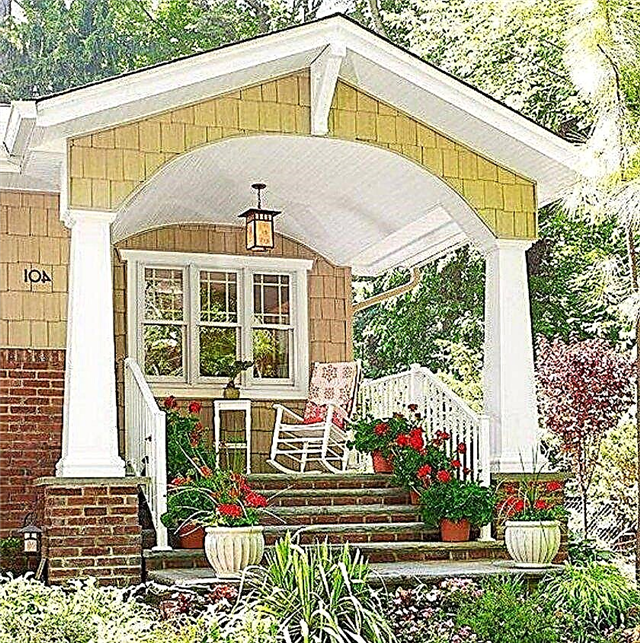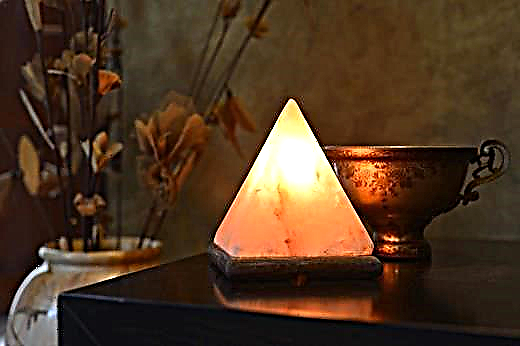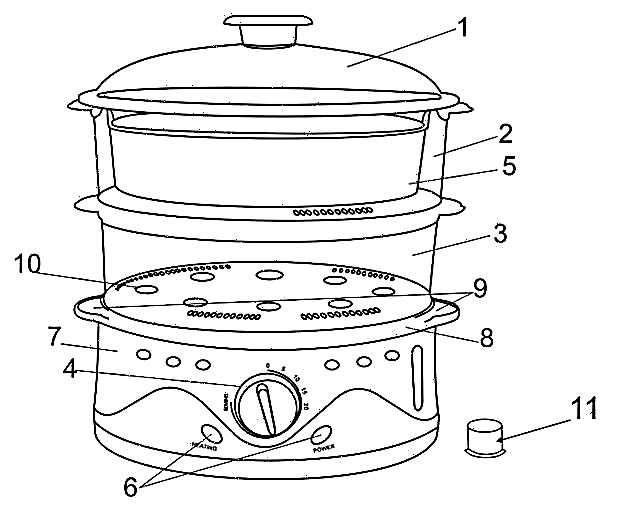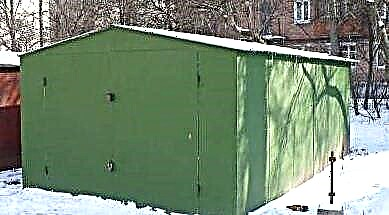Among the decorative elements in the garden, the most popular are garden figures. They not only decorate the site, but also give it personality. These are the highlights of the garden, which enliven the whole design and create magic. Almost all owners of a private house or cottage have garden figures. They are easy to find in gardening or gift shops.

They are made of different materials - gypsum, wood, concrete, stone. This decor for the garden is distinguished by a variety of subjects of figures, their sizes, design and price.

How to choose a figure for your garden among such a variety?
First of all, you need to pay attention to size and shape. If the garden has long grass and tall flowers, then you need to choose products of large sizes so that they are clearly visible.
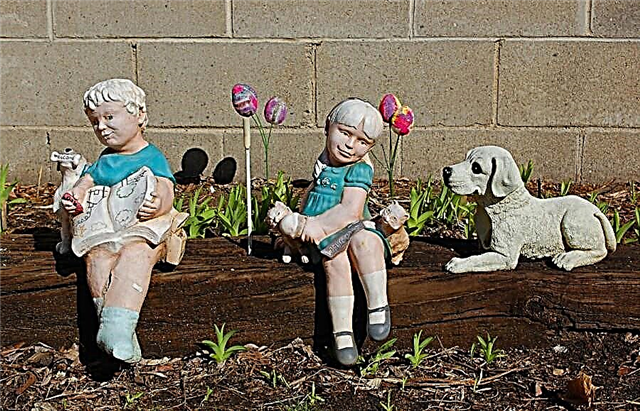
When the figures are planned to be placed on the lawn, we advise you to take any, they will be clearly visible from either side of the site.
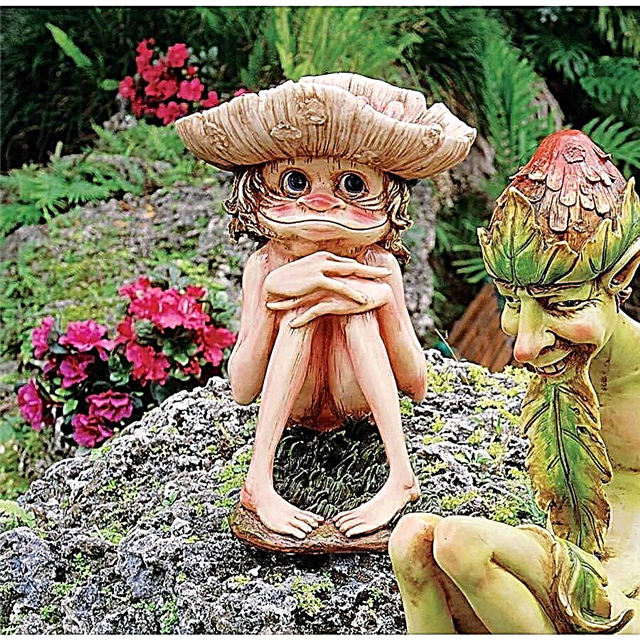
If the figures will stand near the flowerbed with bright colors, you need to choose products of white, black, gray shades. Then they look on the site the most profitable.

And on a site or path made of tiles, stone, ceramics, colorful figures of different shapes are needed - these are gnomes, animals, birds.

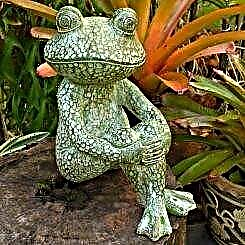


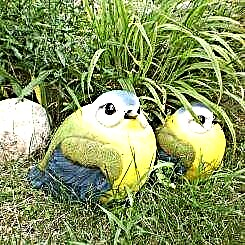
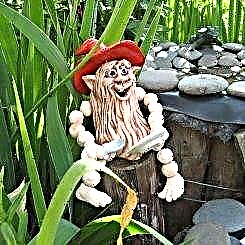
You can pick up a set of products on one common subject, which put across the entire area of the garden. They will create increased comfort on vacation.
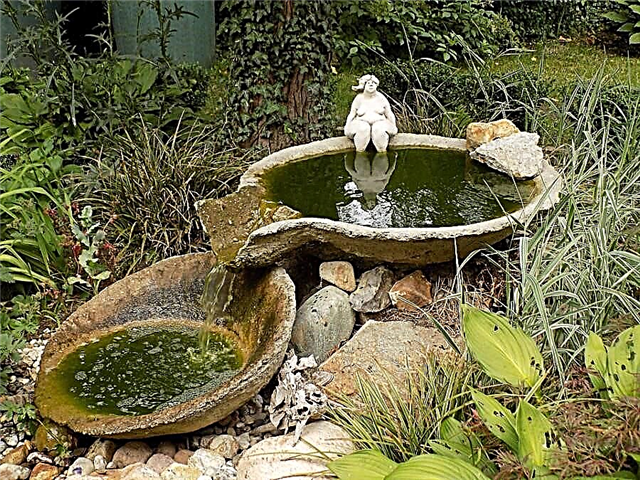
Garden style with figures
Figures for decorating the garden should be in harmony with other elements of the decor and with the style of the plot.
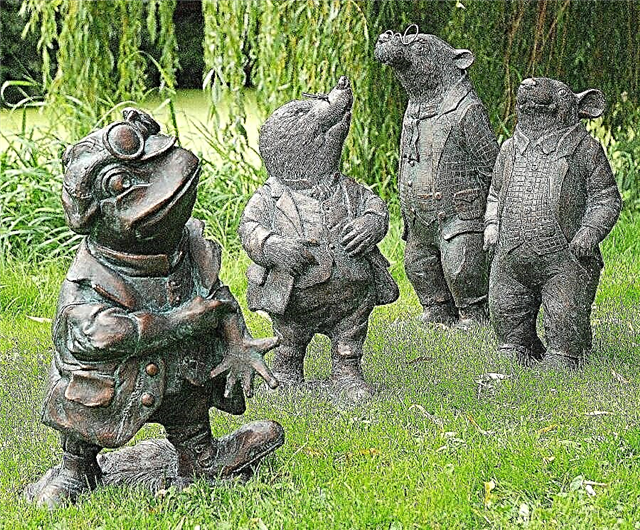
If the front garden is in the country style, then you can safely arrange the figures of gnomes, cats, geese, hens, goats.
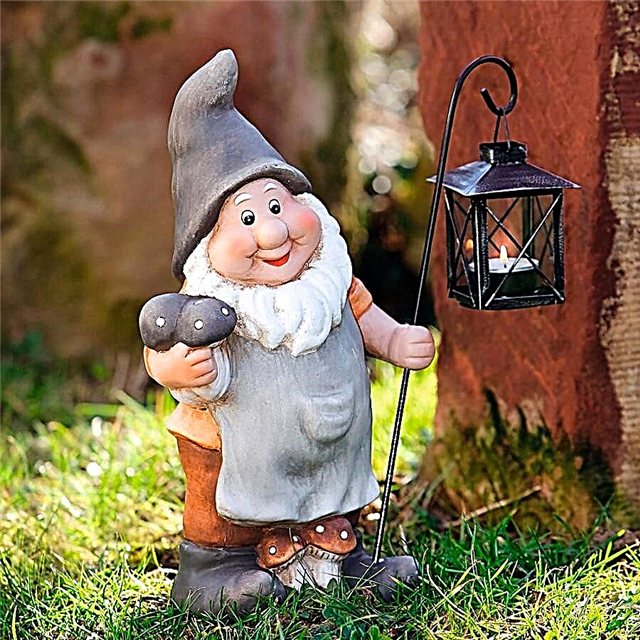
In the oriental style, restrictions on the number of figures are appropriate. A lion and a dragon will live well in it.
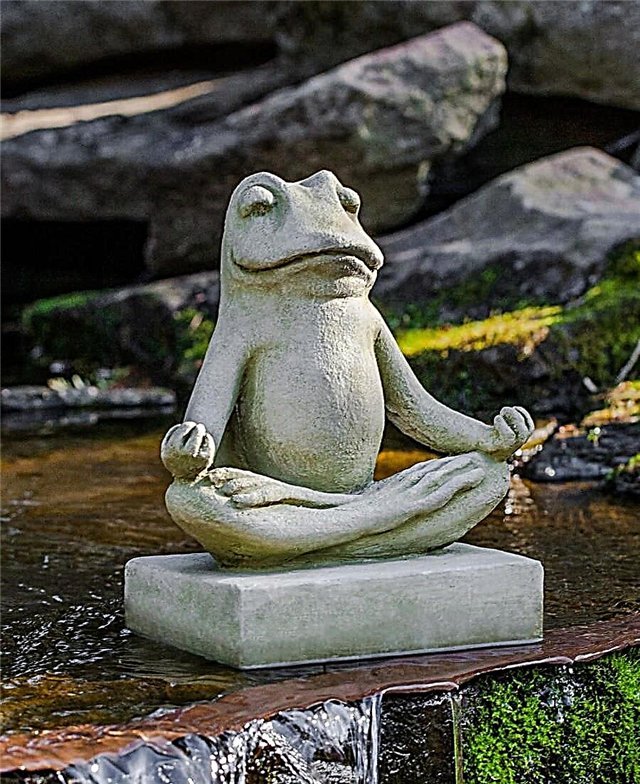
For the village garden, figures of both animals and people, heroes of fairy tales are suitable. The main thing is a sense of proportion. For example, if the main character in the territory is a cow figure, then other animals are placed in different corners of the site, but smaller.
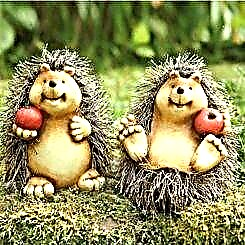
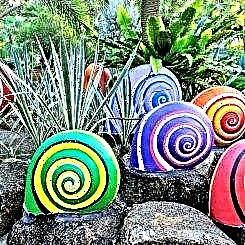
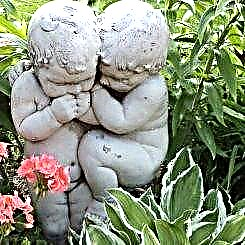
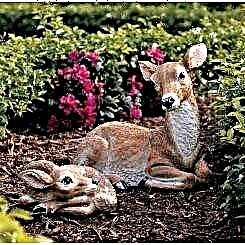
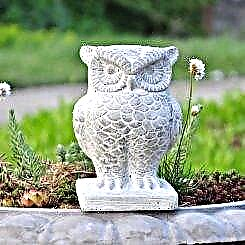
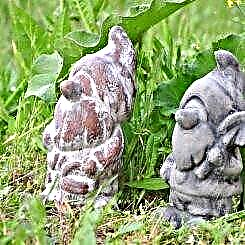
In Japanese style minimalism prevails. This garden has more stones than figures.

The classical garden is decorated with figures of marble, bronze, wood.
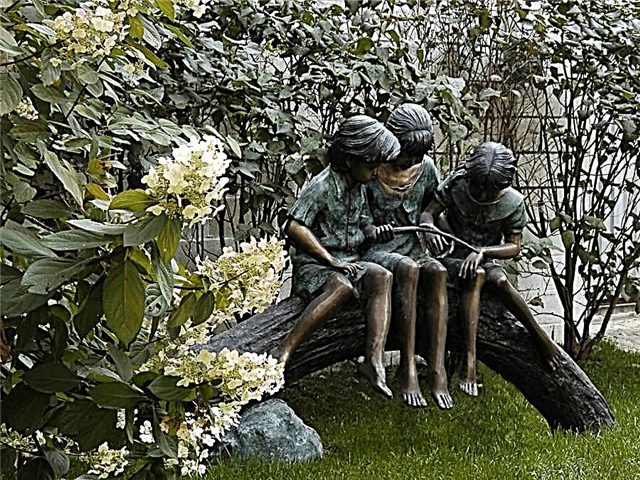
DIY garden figures
In the presence of free time and desire, such figures can be made with your own hands.
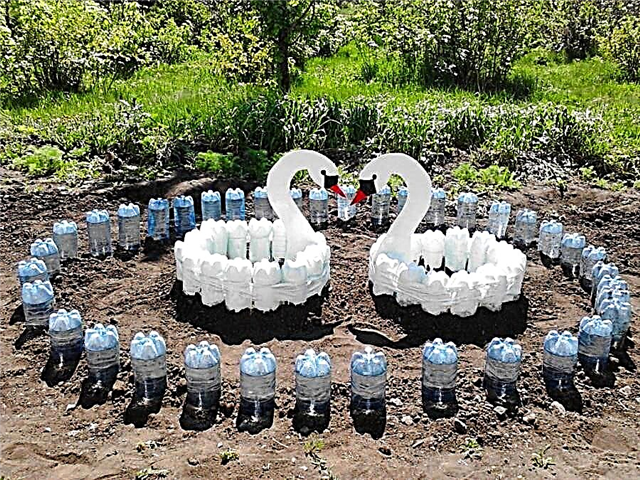
When a person has artistic abilities, it is easier to create original, unique products to decorate the garden. But even without the artist’s talent and skills, it is really possible to realize any idea.

Master classes in the manufacture of such products from improvised materials will help beginners in this work. A photo of garden figures will inspire this work.
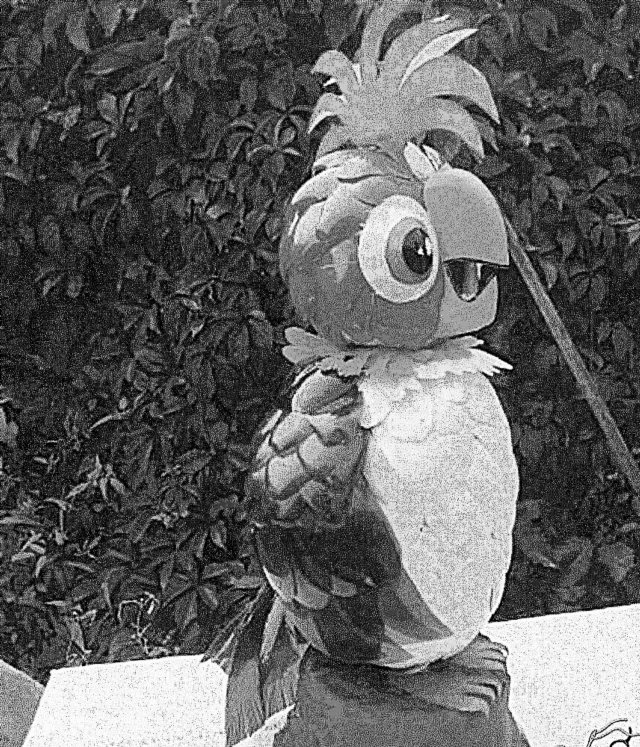
The material for creating shapes can be very different. These are wood, gypsum, cement, concrete, clay, polyurethane foam, plastic bottles, plywood.
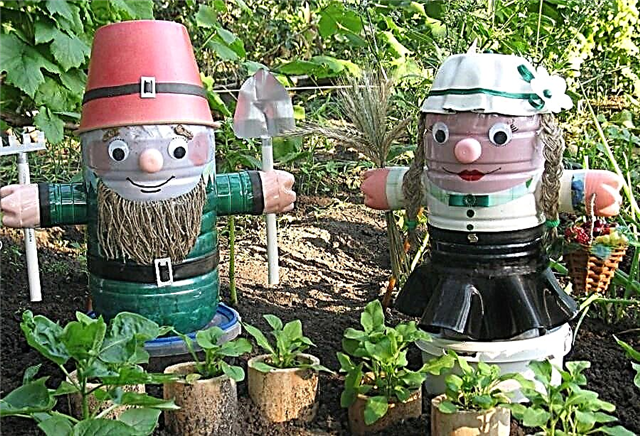
One of the most popular materials for garden figures is wood. According to popular belief, a tree is a source of life, and wooden figures attract people very much. It is as if warmth lives in them, and therefore the figures of the forester and other forest monsters do not seem scary.

From wooden planks and rods, you can build a well, a house, small benches (30 cm).

Polyurethane foam figures are very durable and water resistant. Of these, a wide variety of birds and animals, fairy-tale heroes are often made.
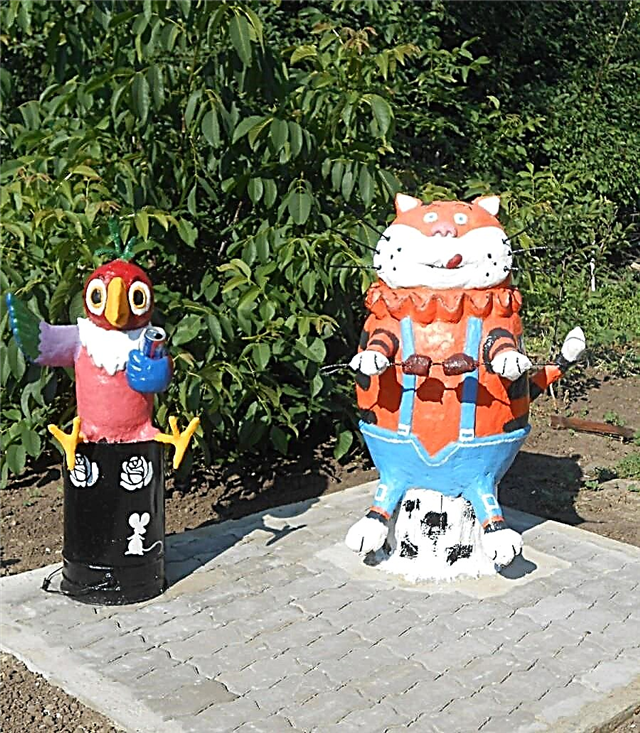
To make a burro, first make a wire frame. Then the foam is gradually applied in several layers, allowing them to dry, and then treated with a moisture-resistant grout.
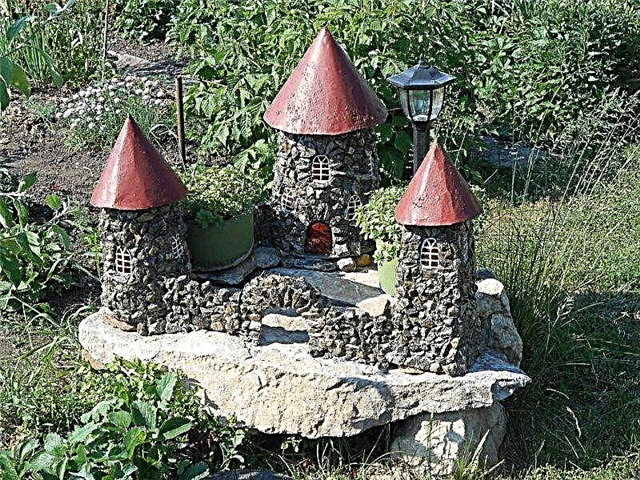
And for the bun, you need to make a hole in the ball, fill it with foam. Then cut the ball, get the ball and color the bun.
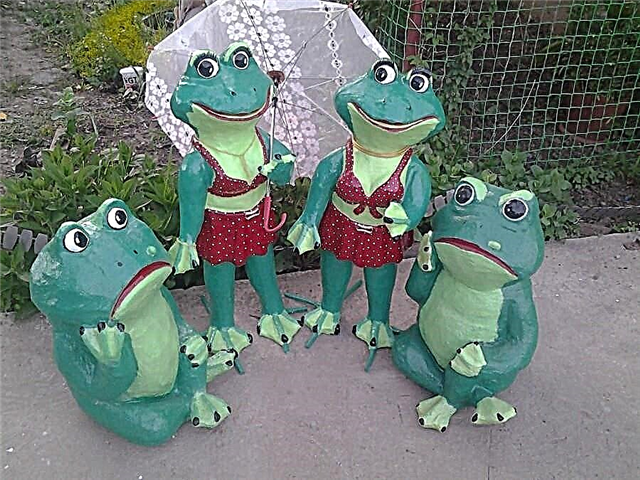
Gypsum figures are best made small, although gypsum is a durable material. It quickly hardens. To preserve the product for a long time, it is coated several times with paint.
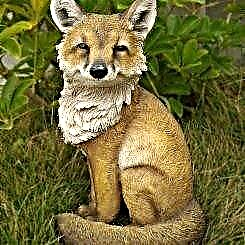
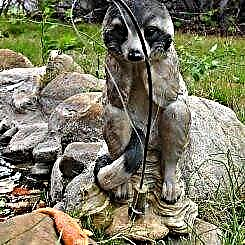
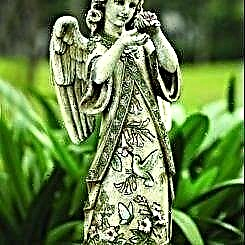
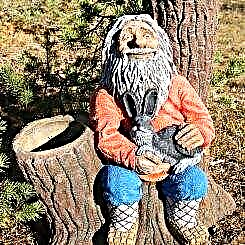
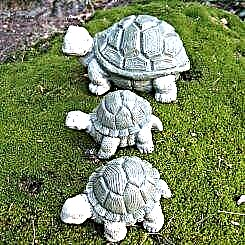
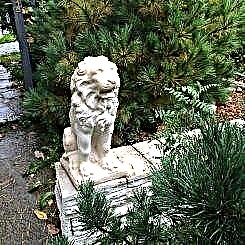
Often special molds and other containers are used. For the tortoise figure, you need to take a round shape and fill it with gypsum. On a frozen circle, cut circles and hexagons. Then attach the head and paws. At the end to colorize.
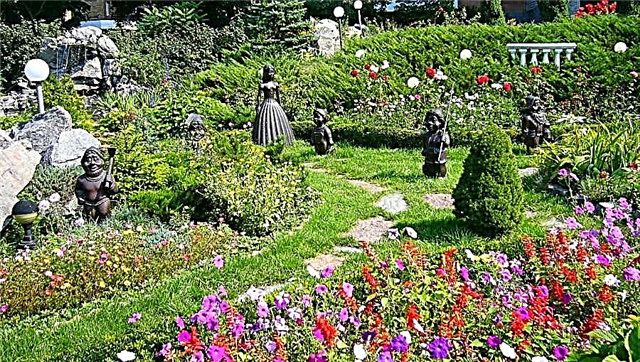
You can also make a flowerpot and flowers. For a large model of the product, a reinforced frame is needed. At any dacha there are unnecessary glands - pipe cuttings, metal cans, springs. Very interesting figures can be made from them. Fasten them by welding.

The simplest shapes are made of cement - mushrooms, ladybugs. Cement mortar is poured into the desired container, covering it first with polyethylene. This will make it easy to remove the product from the mold. The finished figure is painted with paints.
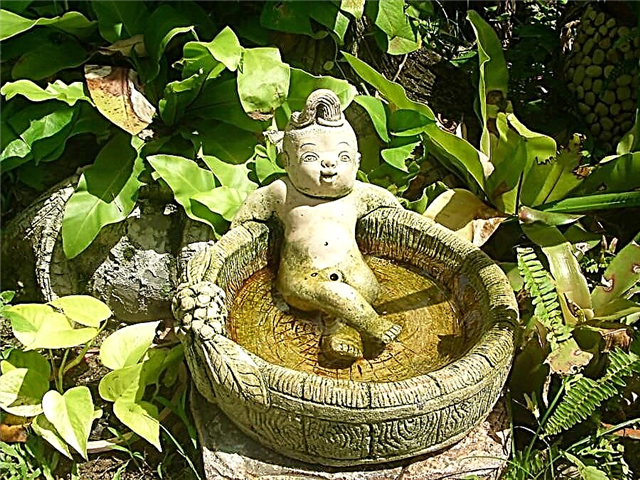
The most unpretentious material for making figures is plastic. He is not afraid of the sun, snow, rain.
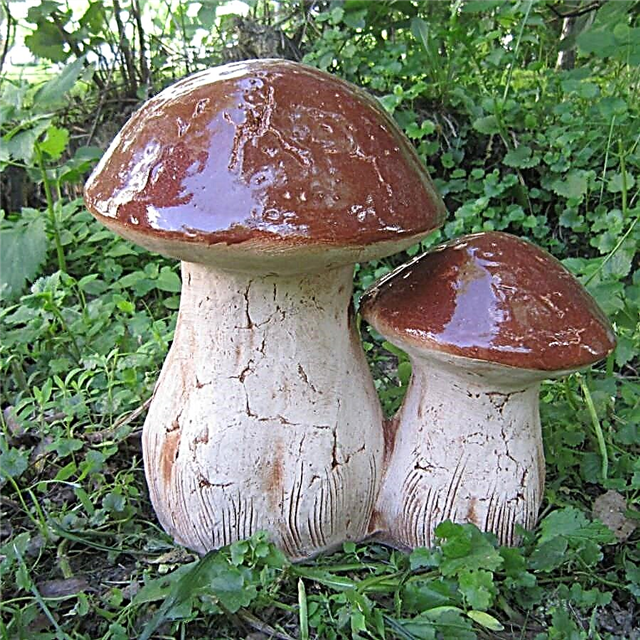
From small bottles you can make bees. They are painted with colored stripes, wings are attached, the antennae are made of wire.
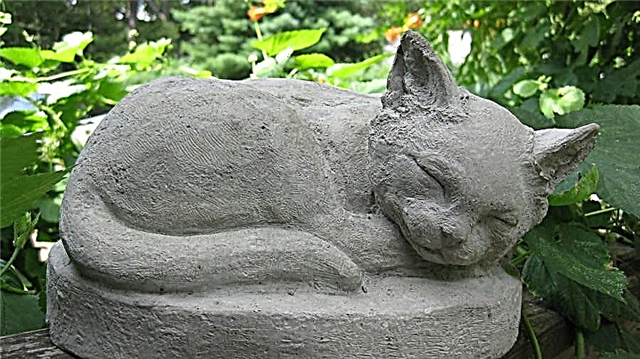
A palm tree can be made from brown bottles and green ones. Browns are cut, inserted one into the other, the trunk is obtained. Lush leaves from green blanks cling to the tops.
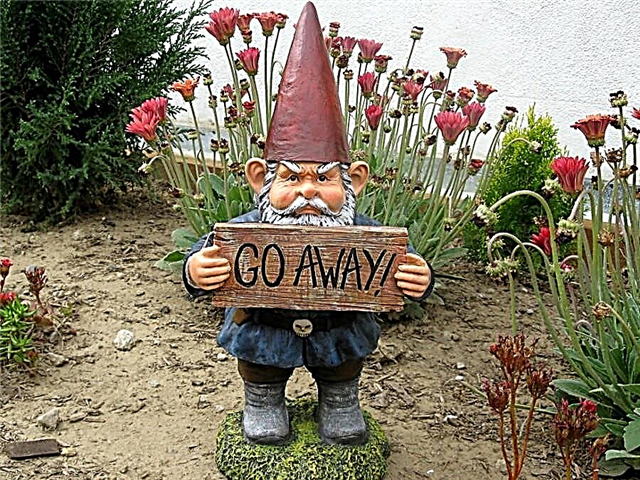
The most popular plastic figure is the stork. The basis for the body is a bottle of 5 liters, parts from bottles are smaller. If the bottles are colored, they are painted at the end with white acrylic paint.
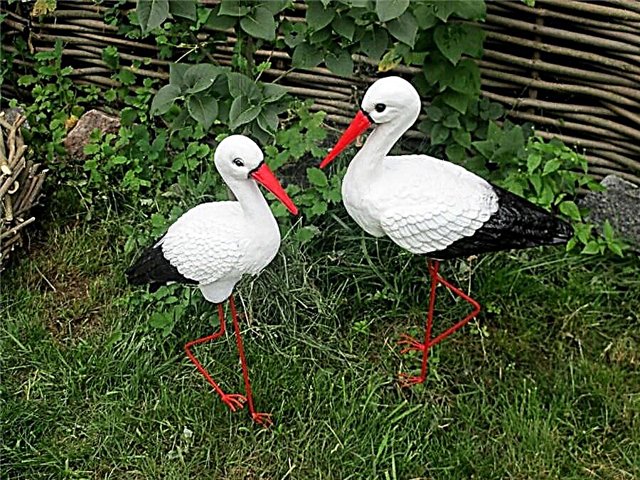
A stone figure requires a suitable stone of a certain size. An ordinary cobblestone can turn into a kitten, puppy, ladybug.
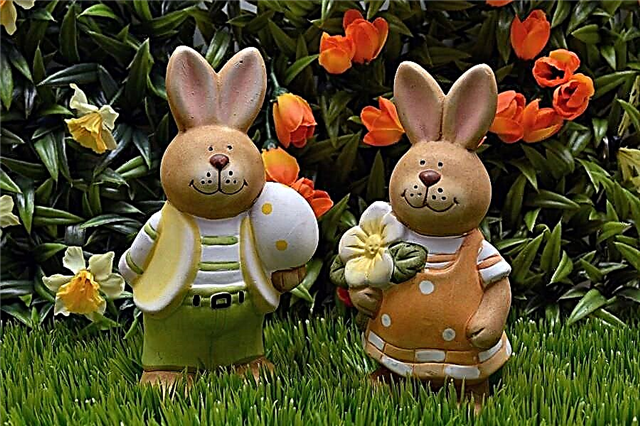
Unnecessary household items, toys and furniture can act as a garden figure.
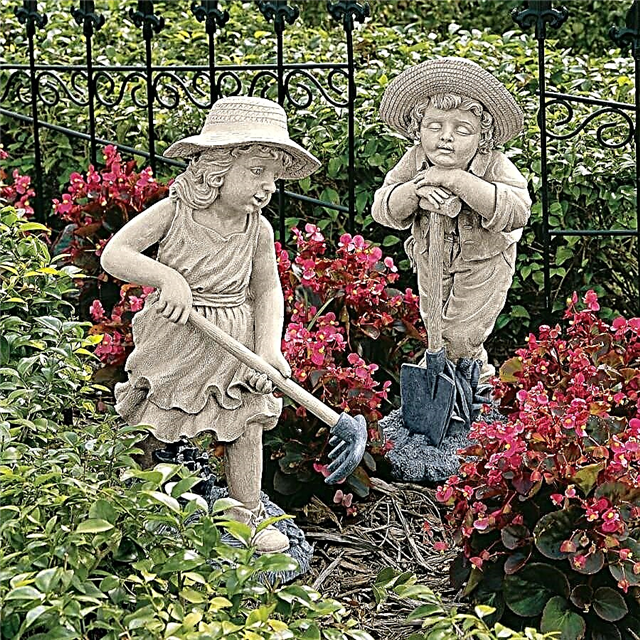
So a large old basket, a watering can, a baby car, a bathroom, a caravan, unwanted dishes, old shoes can serve as a flower garden.

Broken old tiles come in handy for paving paths or decorating a flower garden.
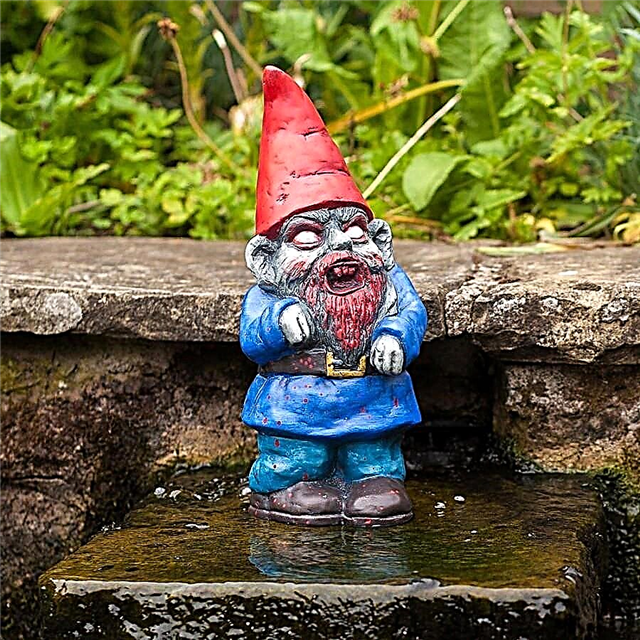
As you can see, to build garden figures with your own hands does not require large material investments. It requires only free time, desire, skillful hands and creativity. And then the beautiful figures in the garden will take pride of place on your site, giving it comfort and warmth.
Figures from cement: what are good and how to do
You can make garden figures from cement - this is one of the most used and affordable materials. It is inexpensive, it allows you to create a variety of figures - from simple and small, to sculptures in full growth. There are several ways to make garden figures from cement mortar: with a frame, without it, from a semi-dry mortar. More about everything further.
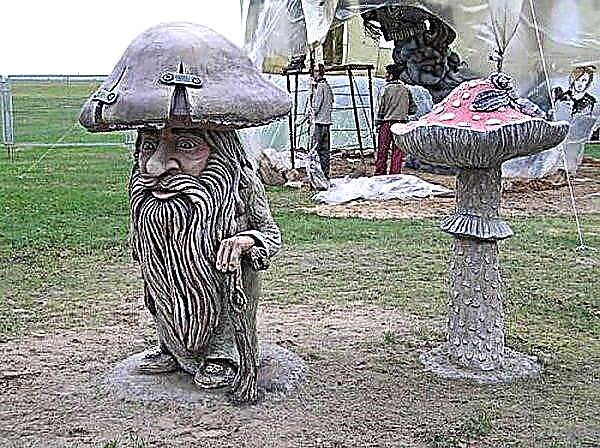
Mushrooms are often made of concrete, but they are not always the same ...
What to add to the solution
There are many cement additives that improve / change its properties. There are a lot of them, but they are sold in rather substantial volumes, which may be needed only for the manufacture of garden sculptures on an industrial scale. But there are common substances that also change the properties of concrete mortar.
- PVA glue - increases the frost resistance of the finished product and the plasticity of the liquid solution. He fills out the form better, but he “grasps” faster. The dried cement with the addition of PVA can be treated at times worse than usual. Therefore, do not miss the time while it can be molded.
- Liquid glass - reduce water permeability, the solution sets faster. But it should be added no more than 1% of the total mass of the solution.

Not too common technique: the pattern is copied onto a semi-dry block of concrete, then scraped out with chisels or spoons. The main thing is to be in time before concrete becomes intractable for processing
These are the main additives that are needed in the manufacture of figures for the garden of concrete. It’s easier to work with them. But do not add much. The maximum is one teaspoon per bucket, otherwise you will only make it worse.
How to paint and some technological nuances
After the concrete figure has dried, it must be sanded to smoothness, dust removed and can be painted. To paint lay down more evenly and spend less, first you need to cover the product with a primer layer. The primer is selected depending on the type of paint. The painting process itself is no different - usually you need brushes of different sizes. But you should know some features.
- Acrylic paints after varnishing become brighter.
- Can be painted with floor paint (enamel PF 115).
- Aerosol paints in cans are good - from automotive to interior. But the best option is for outdoor work. They last longer.
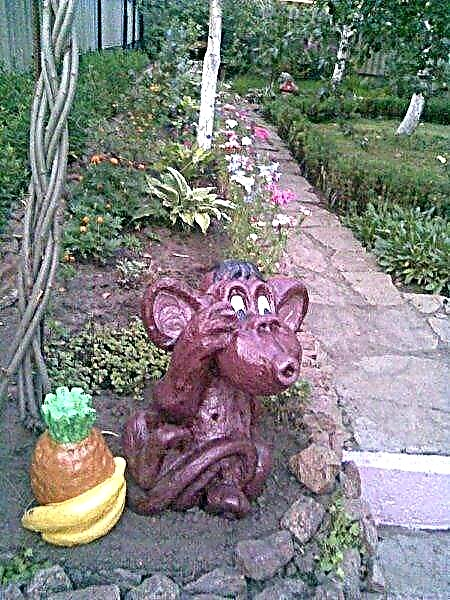
Normal floor paint holds well
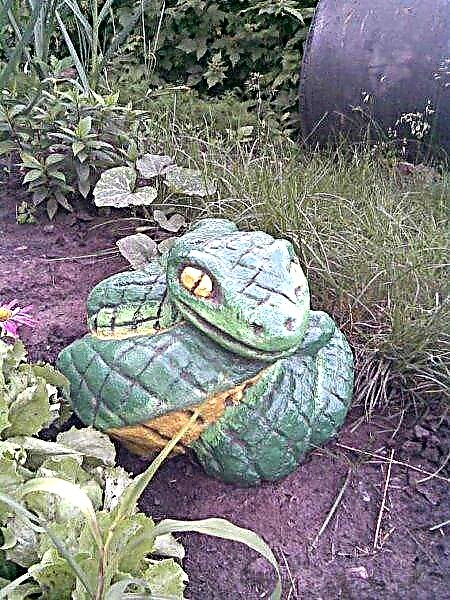
This snake was scraped out of a concrete monolith
There are still a lot of different technological nuances, but these are the main ones. The rest you master or come up with during the work.
How to make garden figures: cutting from a semi-dry solution
It will not work to make garden figures from fresh cement-sand mortar - it is too liquid. Even if you mix it with a minimum of water, nothing intelligible to dazzle will not work. But you can wait until the solution begins to harden, but remains still quite soft - it will crumble under pressure. In this state, it is possible to make grooves in it with a metal object, cut off excess.
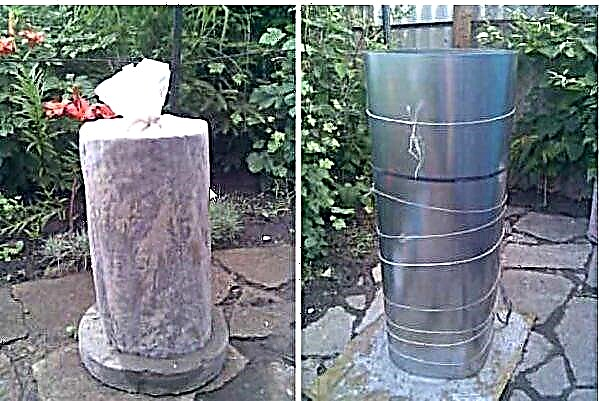
Monolith shape blank
From a thick mixture, you can form an approximate form of the intended character - put it in a piece of film, tie it, give it the desired shape. If there is a liquid solution, find a more or less suitable container or use the same film. The solution in the form is left for 8-12 hours. The time depends on how much cement was originally liquid and the temperature at which you withstand the product. The optimum temperature is about + 20 ° C, with a lower hardening time it increases, and at a higher one, there is a possibility that the cement will dry out, and not “seize”.

Gradually a figure emerges from the block
Periodically check the condition of the workpiece: there should be a solid mass under the fingers, and when you apply more force, the cement is slightly pressed through. In this state, it is already possible to begin to form a sculpture. You have 7-8 hours to work. For small figures this is more than enough, for large end-to-end - you have to hurry. To delay the drying of parts that are not yet processed, they can be wrapped with a wet rag.
Take a knife, wire, spatulas, begin to cut off a little excess. They do not need to be afraid, if you remove something superfluous, you can add a little solution later and correct it when it dries. In general, the technology is not too complicated, but if there is no artistic ability, it is difficult to come up with something intelligible. For such cases, there is one trick: find a small figure from any material, looking at it you sculpt it.
Making figures of cement with a base or frame
The manufacturing technology of garden figurines made of concrete on the base consists in layer-by-layer application of mortar to the frame. But this technique is required in the manufacture of large figures - about 150 cm or more. Then the bearing capacity of the concrete itself may not be enough. In this case, a rigid base is necessary. In other cases, the frame or base is needed only to minimize concrete consumption and reduce the total weight of the product.
The frame for complex products is made (weaved or boiled) from wire, for simpler materials, improvised materials are used. A layer of a solution (thick) of 1-2 cm is applied to the finished frame, it is laid with a fiberglass mesh-serpentine, the solution is applied again, again the mesh. The process alternates until your product takes on the desired shape.
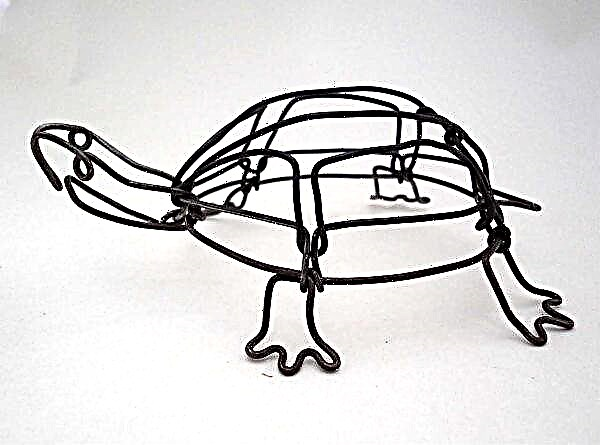
Example: tortoise wire frame
Where and how to find the basis
The main task is to find a dish, a bottle, a box, which in shape is suitable for the intended product. If the shape is complex, it can be grown or completely created from pieces of foam. It is lightweight, well cut. But such figures - with a foam base - cannot withstand the load. If you assume that someone may sit down on your products or mechanically act in some other way, it is better to use wooden blocks or foam concrete blocks instead of polystyrene foam. Foam concrete is perfectly cut with a saw on a tree, it can be planed with a planer, a large knife, grooves with a sharp object. The principles of working with wood are known to everyone.

A frame may be needed if you want to recreate an exact copy of an animal or plant.
The found form is covered with a solution, wrapped with rags, tow, ropes, and then also coated with cement. If the mortar layer is more than 2 cm, it is reinforced with a fiberglass mesh (sickle mesh is used for plastering walls). If plastic is used as a base, it is very difficult to apply a solution to it - it drains. Such products are wrapped with rags soaked in a solution. After drying, the next layer is applied very well on them.
In a dried solution, grooves are made, which indicate feathers, wool. In general, there are many tricks. Here are a few examples to make it clearer how to make garden figures from concrete. Another option is to be coated with a solution in which pebbles are pressed. It creates an uneven terrain.
Swans
For example, we want to make swan figures. The basis for the body is a small rounded basin. The neck is a wire curved in the form of the letter S. We attach the “neck” to the body in any way possible.

We put a thick solution on the basin, forming the desired bend, add polystyrene, pieces of rags, etc. Leave to dry. On the wire (it is better to find a thicker, you can fittings) we wrap rags soaked in a solution. We fix and leave everything for a day. During this time, the concrete will set, and on the “body” it is possible to form wings with the help of curettage, make grooves, draw feathers, etc.
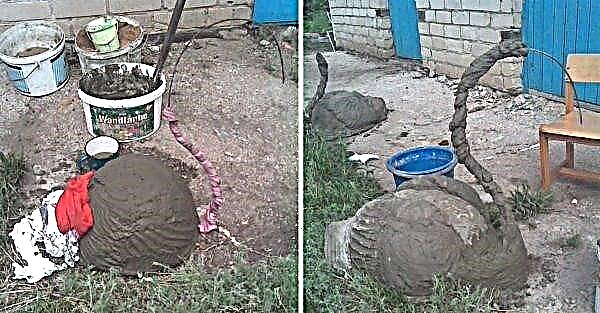
Tightly deal with the neck and head. We put the solution on the resulting base with your hands (do not forget to put on rubber gloves), forming the neck of the desired shape and thickness. It’s impossible to “build up” much at once - only in thin layers. When the neck becomes more like a real one, you can start the formation of feathers, outline the beak, eyes, etc. Ready birds leave to dry for a week or more. Next - grinding, primer painting.
Frog princess
This example will demonstrate how you can make garden figures from cement mortar and stones. The foam block is taken as a basis, trimmed and trimmed where necessary. Top coated with a thick solution in several layers.
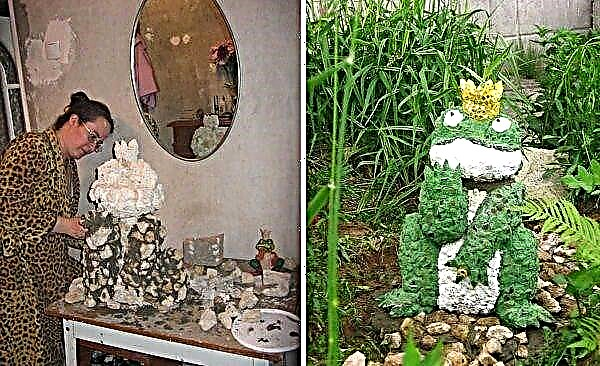
How to make garden figures: a frog made of concrete and stones
In the upper, still soft layer, pebbles are strengthened - flat pebbles of small size, glass fragments are used on the crown. After drying, the figure is painted with acrylic paints, varnished twice.
Frameless technology: concrete drinker
If the product is small or thin, a large load is not planned on it, you can make it without a frame. So do all kinds of bowls, plates, small sculptures. For example, a drinker for birds in the form of a leaf. It can also be a stand for flowerpots and flower pots, other figures that do not want to contact the ground.
We find a large leaf - burdock, rhubarb, etc. We put the sheet in water, from sand on a flat surface (table) we form a shallow slide, cover it with a film.
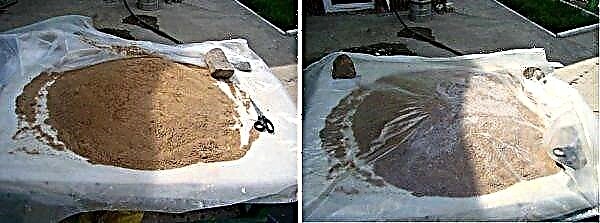
We form a bowl on the contrary
We lay out the sheet on a hill, pushing it into the sand. Knead a thick solution - it should not drain. The composition of the mortar for sculptures is 1 part cement, 3 parts fine sand, a plasticizer can be added. We spread the solution on top of the sheet, pressing it tightly. In the middle, the thickness of the layer is about 2 cm, to the edges it becomes thinner - up to 1 cm. Form the edges carefully. They can be laid out, but this is not so simple.
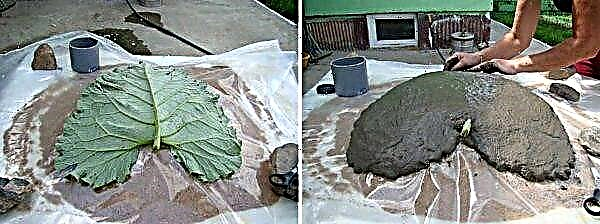
Coat the sheet with a solution
In the middle we insert a piece of plastic pipe with a diameter of about 10 cm and a length of 10-15 cm. We rub the joint at the junction with a solution, fill the pipe. Cover with plastic wrap. It protects from overheating, rain, dirt. We press the edges with stones or something heavy, but we don’t need to achieve tightness - excess moisture should evaporate.
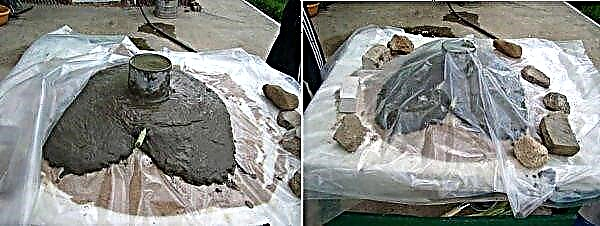
Almost done, left to wait
To sustain a garden sculpture without turning over for at least 2 days. Then remove the outer film, gently turn it over, remove the sheet. If it does not leave, moisten and wait a couple of minutes. Brush away residues, trash. Wait a few more days before painting - preferably two weeks.
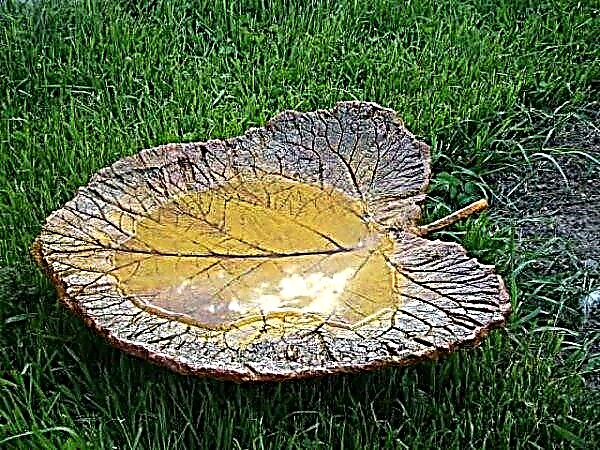
That's what happened ... the original bird drinker
Before painting, sand with sandpaper, remove dust. If desired, can be coated with a primer. Its type is matched to the type of paint. The primer is needed so that the paint lays more evenly and so that it is spent less. When the paint dries, the product is covered with two layers of varnish. Choose a varnish for outdoor work. Better - matte or semi-matte.
Decorative figures from polyurethane foam
Very quickly and simply it is possible to make garden figures from polyurethane foam. Just keep in mind that they are very lightweight, so some weighting materials are needed. Plastic bottles, metal containers, cardboard boxes, etc. are suitable as a basis. For thin parts - arms, legs, necks - any materials of the desired shape and size are suitable: branches, wire, wire frame, plastic pipes, metal corner, etc. etc.
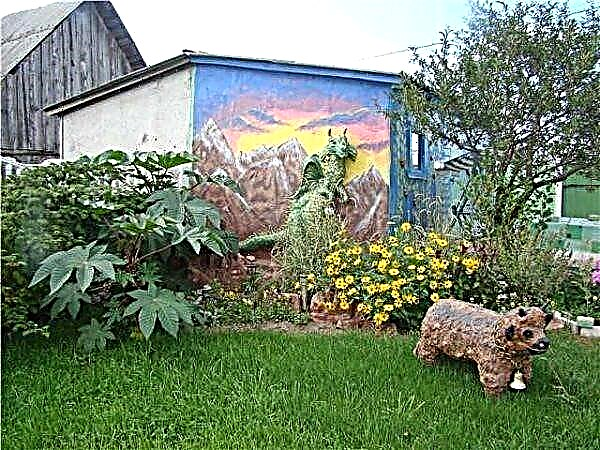
This is an alpine goby made of foam. There is no need to specifically do wool either: the foam itself forms the desired relief
The basis for thin or strongly protruding details of the figures can stick in later - after the "body" is ready. You can simply stick a wire, a corner, a stick in the dried foam. If soft materials are used, they can be nailed with carnations or screwed with self-tapping screws, grab with staples from a stapler, and glued. In general, use any available method.
It’s better not to save on the quality of the foam - choose an expensive one. It does not flow like a rising yeast dough, but increases in size, keeping the shape specified during application. But even with expensive mounting foam, do not rush. The main secret is: apply a thin layer at a time. Then wait until it stops increasing in volume, hardens (25-40 minutes) and apply the next thin layer. Such a consistent increase in volume is the key to success.
How to choose decorative figures for the garden?
When choosing decorative figures for the garden, you should know one important thing - it can both emphasize a certain place and spoil the visual impression. Garden figures is a great option to add a touch of originality and uniqueness to the design of a corner of nature at the cottage.
Several rules that must be followed when purchasing or creating figures:
- The overall plot should be one for all designer decorative figures.
- You should not buy products that differ from each other in structure (material, manufacturing technology).
- Do not limit yourself to garden gnomes alone. In our catalog you can see a huge assortment of products on various topics.
Classification of decorative figures
Every day, art acquires new facets to meet the tastes of even the most sophisticated and picky customers. Nowadays, you can buy or order products consisting of a wide variety of materials, including:
- Gypsum
- Polystone
- Wood
- Concrete
- A rock
- Composite and other materials
Plaster figures are a pretty cheap treat. Ecological purity makes them popular, but they can easily break if dropped.
Also, rain and temperature changes are harmful to gypsum figures. Their service life does not exceed 1-2 seasons. After which, the product must be repaired.
Polyresin garden figures represent the middle ground of the concepts of "price" and "quality".
Due to the reliability of the materials used in the manufacture (of which artificial brick is also made), such decorative figures can stand on the street for more than one year, while they do not lose color and do not peel off.
The only limitation is the small size of the figures themselves. For growth or giant models, manufacturers use fiberglass.
Wooden figurines have long been common in Russia, since it is not difficult for a skilled person to make them.
Now the production of wooden figures has reached significant heights, which allows you to recreate fairly detailed models.
Particular attention should be paid to the quality of the painting, since how much the garden figure will serve you depends on it.
Concrete sculptures are an example of reliability and durability.
Such a thing will last more than one year, decorating the garden and emphasizing the wealth of the owner of the home. An important role in the creation is played by the quality of the mixture, so ordering such work is necessary only from a reputable company.
Natural stone will serve no worse than the most reliable concrete. Bad weather can spoil the structure of the figure over time, so you need to periodically conduct a small restoration.
Various materials by type of tires and plastic are not durable, but the figures from them can boast of originality and a variety of forms. Such products can be made by yourself and do not necessarily have a number of special skills.
So, to create a unique atmosphere of your summer cottage, you can buy garden figures of various shapes and sizes, starting from the requirements for quality and reliability of products. A variety of figures of animals, plants, trees and fairy-tale characters can be ordered from specialized masters or created with your own hands - the design is limited only by our imagination and, sometimes, budget possibilities.
From plaster
Gypsum figures for the garden are often made in the form of animals, ceramic men or birds of unusual colors. If the wrought-iron sculptures and figurines made of a half-stone are perfectly preserved in the outdoor environment of the summer house, then landscape figures from plaster should be removed from the garden at night.
Before making gypsum garden figures, you must acquire the casting mold yourself. The shape will also be a toy, plastic bottles for giving or children's molds.
To make the landscape sculpture dense, the plaster decoration is wrapped with wire, and unnecessary plastic containers are placed inside. So the plaster decorative figure will be easier, and its manufacture will be cheaper. If the landscape sculpture of an animal or bird is large for the garden, then it is made by combining plastic parts.
It is difficult to cast a decorative figure, since gypsum or a half-stone can be unevenly distributed. During the manufacture of gypsum figures for the garden with your own hands, it is necessary to uniformly distribute the solution over the voids of the toy.
Small decorative gypsum figures harden almost immediately, and it is not necessary to display large landscape sculptures of polystone with forged parts immediately in the garden. If it is necessary to cover the forged figure for the garden with a different color, then the sculpture needs to be dried for longer.
Made of rubber
Rubber figures take root well in the garden and create an entourage in the garden due to their flowers. It is most difficult to make such a figure without instruction.
At the cottage, a decorative sculpture of a swan deserved special popularity. Rubber is prepared before the manufacture of the figure, making marking of noticeable colors. The marked parts are cut with a knife, and the area of the swan neck is fixed with a metal wire. The decorative figure is poured with paint of the color that will merge with the design of the cottage.
The figure of an animal for the garden is made by assembling plastic and rubber elements. After they require painting.
Made of plastic
Plastic raw materials are the reference for the manufacture of landscape statuettes for the garden. The plastic material is combined with the raw material used to decorate the decorative figure.
Plastic bottles are the basis of sculpture for the garden, and you can combine them:
- gluing plastic raw materials with newspaper scraps,
- with fixing plastic parts with wire,
- with decoration of plastic figurines with polystone or concrete,
- using plastic and forged raw materials.
Plastic bottles are a budget material for the garden and are quick to manufacture. They can be easily updated by coating with a different color.
Homemade Figures
The manufacture of garden figures implies their compatibility with the landscape architecture of the cottage:
- if the garden design is made in modest colors, then decorative plastic figures made of polystone or stone will complement the garden,
- for giving with a tiny garden, decorative plastic and forged ornaments in the form of vegetation are suitable,
- decorative forged ornaments with a polystone will be acceptable for the English garden,
- ceramic, forged and plastic decorative figures decorate the cottage of a large family with children,
- plastic swans and wrought iron decorative fountains will perfectly decorate the Gothic garden.
Like and subscribe to the channel, so as not to miss new publications.
Advanced technology and tips
If by steps, then you need to make garden figures from foam as follows:
- Take the base, apply the first layer of foam.
- We are waiting for it to stop increasing in volume and harden.
- Apply the next layer.
- And another layer.
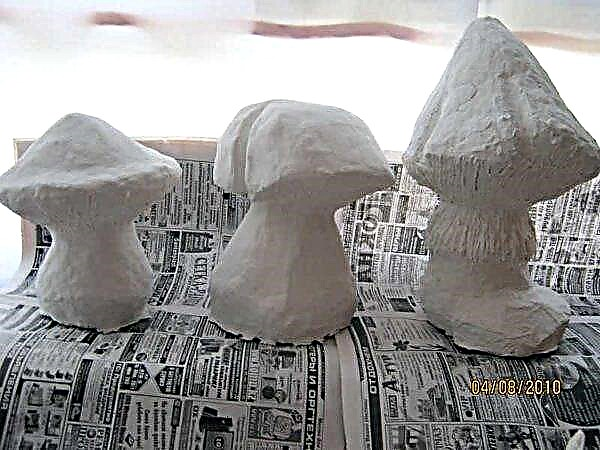
Mushrooms are made of foam. These are raw blanks.

This is the result of labors.
In general, the technology is simple and now you know how to make garden figures from polyurethane foam. But there are nuances. The first. If cheap foam was bought and it began to spread, you need to wait until it begins to harden, moisten your hands with water and form what you need out of it. It is important to catch the moment when the foam is not very sticky, but has not yet completely frozen.

These cracks come after the putty dries.
Second. If part of the figure falls off in the process, it can be fixed by dropping onto the joint with foam, by sticking a piece of wire - for greater strength - to connect the parts. Coat the seam with mastic, putty.
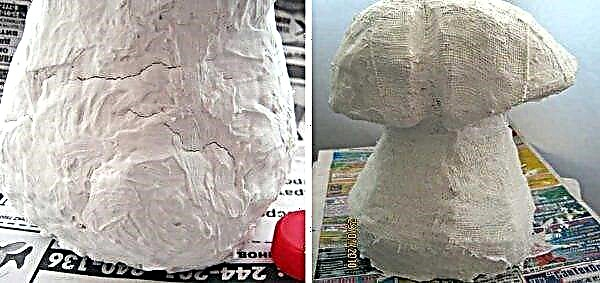
And this is troubleshooting
Third. When the putty dries, cracks form on the surface of the figure. Puttying them with putty again yields almost no result. Cracks appear again. To avoid them, take a bandage, wrap the figure coated with putty, put another layer on top, level it.
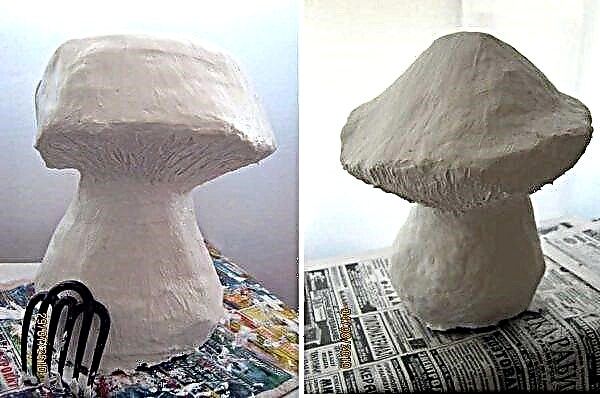
This is after ironing by hands, but still dry
Fourth. If with the help of a spatula it was not possible to get a perfectly flat surface, and you need it, then when the putty dries, you can smooth it by hand. Moisten hands with water if necessary.
What are garden figures made of?
What are garden figures? Often these are cute little creatures made of any material, such as gnomes, squirrels, frogs or kids.
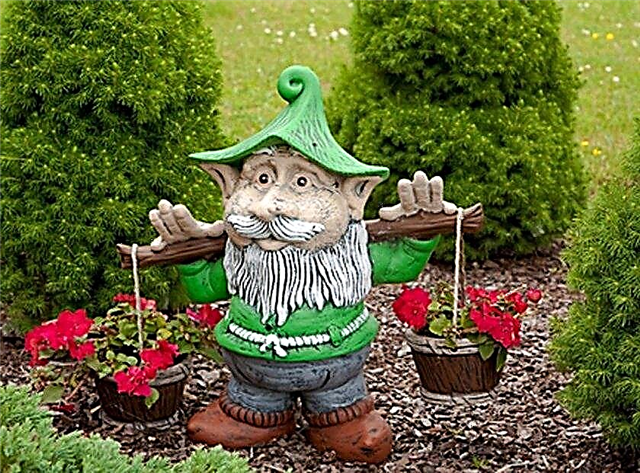
You yourself choose who is more suitable for your garden. The main thing is to observe the rule: if your site is small, then the figure should be small.

Making garden sculptures yourself is much more interesting and enjoyable than just buying a finished figure in a store. A product made with one's own hand is more pleasing to the eye.
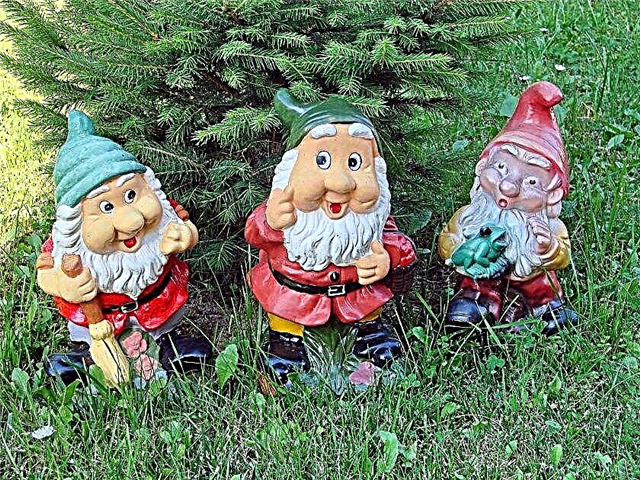
You can make figures for the garden from any materials. Suitable: stones, wood, metal, plastic, gypsum, polystyrene foam, foam, unnecessary dishes or other things.

Now let us consider in more detail which figures are made of these materials.
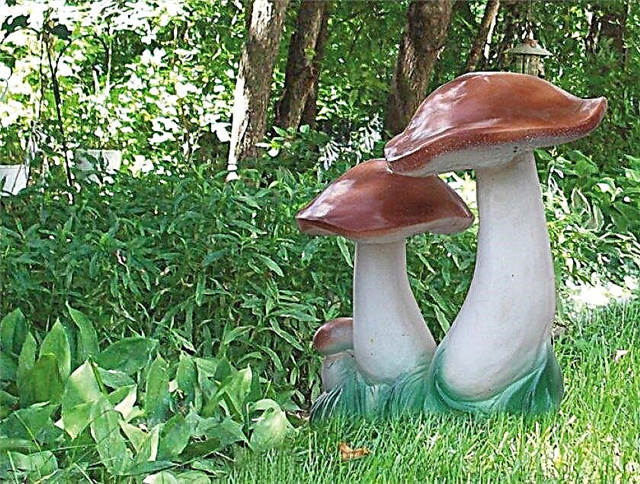
How to make a garden gnome do it yourself?
The first thing people imagine when they hear about garden figures is gnomes. This character is popular in our and other countries.
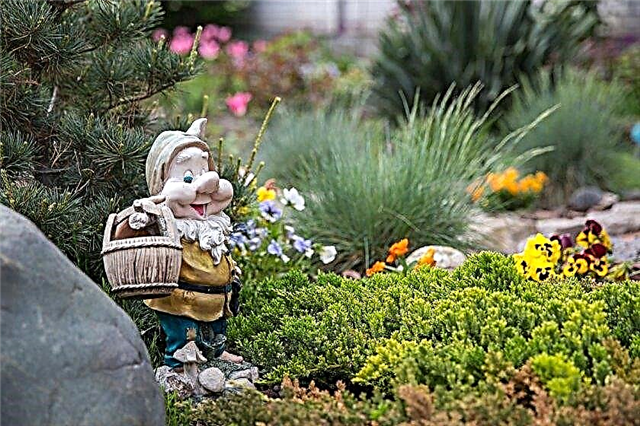
And not in vain - a bright gnome will improve the look of any summer cottage. We talk about two ways to make a little man.
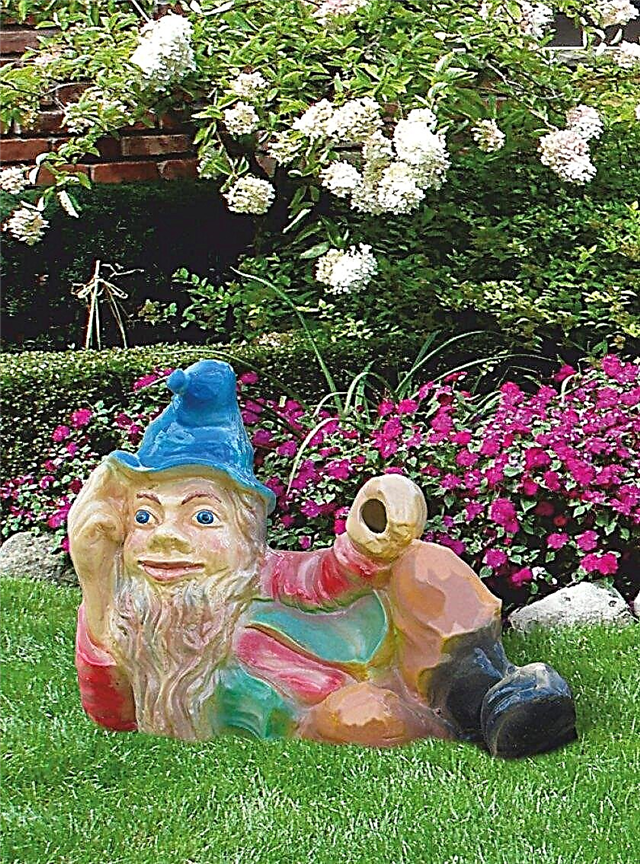
Creating a gnome from a tree. If you have already been engaged in woodcarving, then easily cut a wooden man.
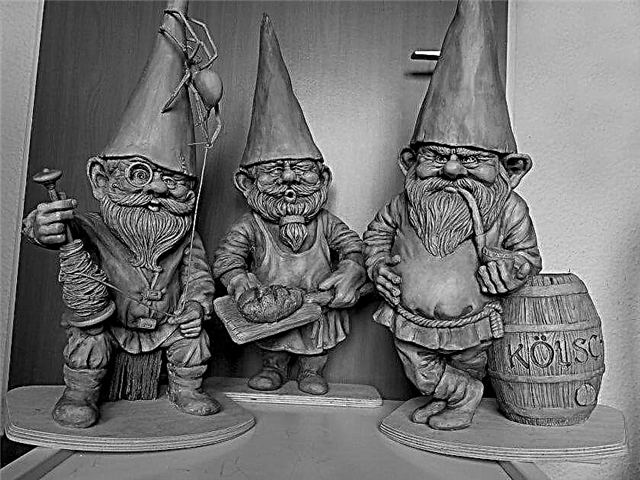
If not, be sure to try. After that, treat your gnome with an antiseptic - it will delight you longer. Then feel free to apply bright acrylic paints. Dwarf is ready!
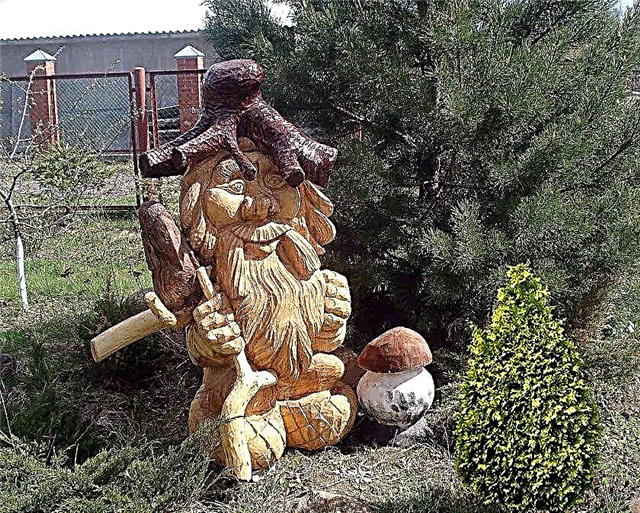
Create a gnome from plaster. The method is a bit more complicated than the previous one, but also interesting. First of all, draw your little man on paper, and then make a frame of metal rods according to the drawing. After that, the most important part begins - modeling on the frame.
Give the future gnome the necessary shape with plaster. Then leave the figure for several days to dry, and after that - apply the paint.
It is worth noting that in such ways they make not only gnomes, but also any other creatures.

Create a foam duck in 10 steps
It is easy enough to make foam garden figures. It is convenient to work with this material with improvised means, and it is moisture resistant. Consider how to make a simple duck out of it.
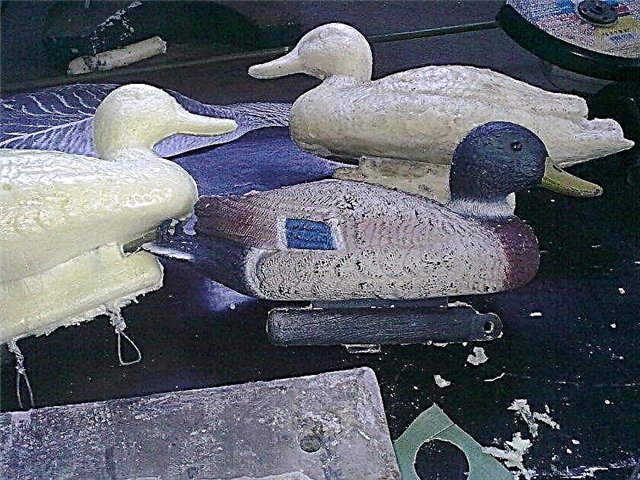
Mark the outlines of the head, neck, body, wings and legs of the future duck with a marker on the foam.

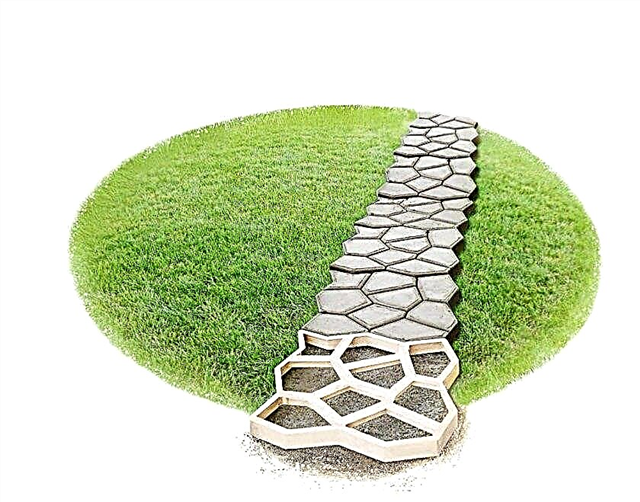
- Cut the workpiece. Do this with a high-quality office knife, but slowly and carefully so that the foam does not break.
- Glue the body parts in at least five places. Use adhesive foam or liquid nails as glue.
- Remove excess material coming out with a knife.
- Glue with polystyrene foam and glue a small tube or bar to the body - this is the future neck.
- Attach a head to it.
- Glue the paws and wings to the resulting figure.
- Cover the duck with putty and leave to dry.
- Sand the resulting sculpture.
- Color the duck.
Other animals are also made from polystyrene. Ducking is one of the easiest options.
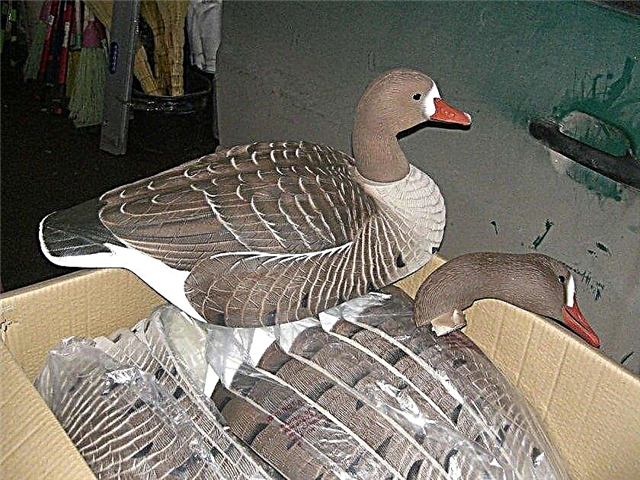
How to make a garden figurine from improvised materials?
It is very simple to create small sculptures from natural materials, for example, from stones. You only need to paint them with bright colors. So you can create a hedgehog, ladybugs, snake, kitten and other animals.
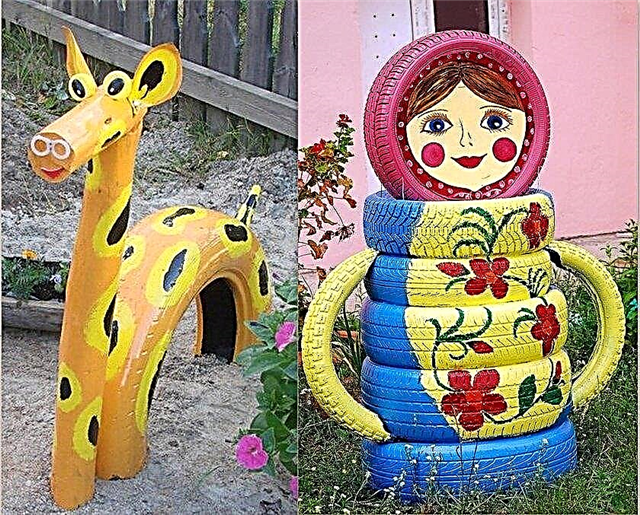
A wonderful figure for the garden is made from logs, as well as from old things. For example, unnecessary tires or an extra teapot. Funds for such a sculpture will be spent minimally, and it looks attractive.
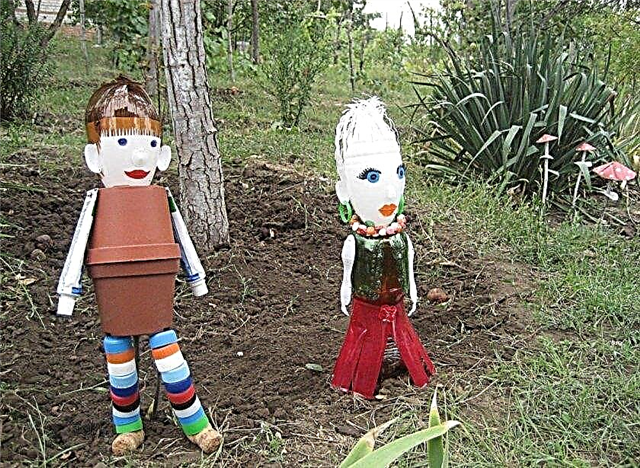
Tip - garden figures will transform your summer cottage, and do it yourself with fun and interesting.
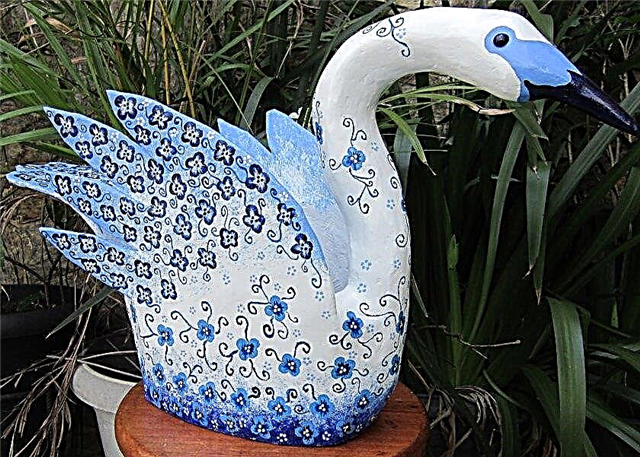
The simple tips above will help you craft a figurine, even if you haven’t done it before. Unleash your imagination!
Photos of homemade garden figures and sculptures
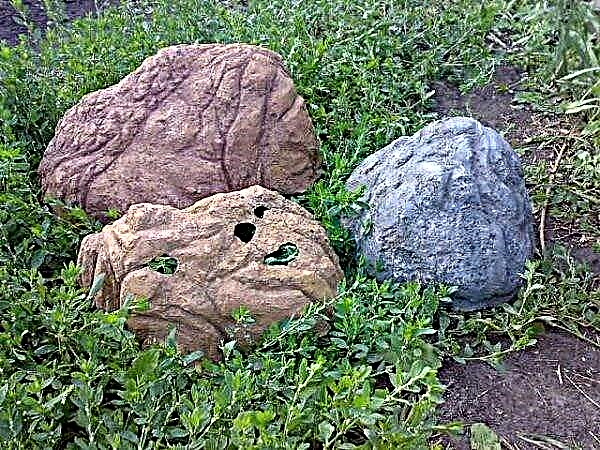
These are concrete stones, but they are hollow inside. The foundation can be made of clay, coated with several layers of concrete. When everything is dry, crumble the clay
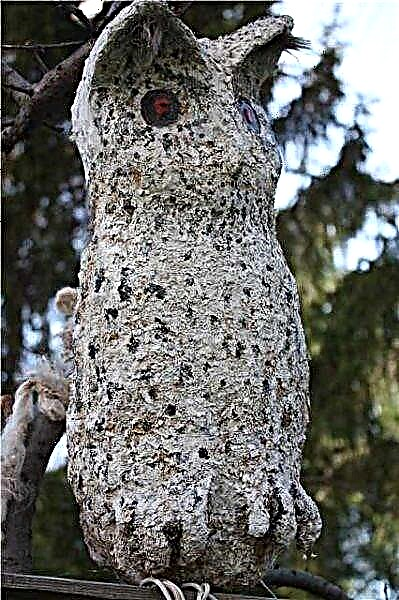
To make the plumage of an owl look like real, sawdust was added to the solution
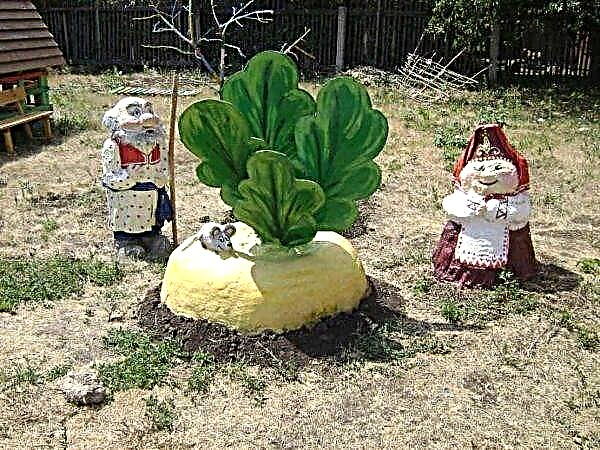
The most interesting thing on these concrete garden figurines is that the clothes are real, just soaked with concrete mortar, and after drying they are painted
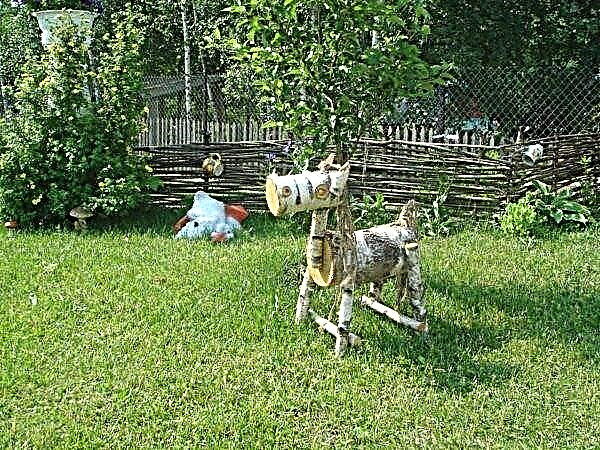
Wooden garden figurines are not necessarily carvings. There may be such - from the logs. Wonderful horse!
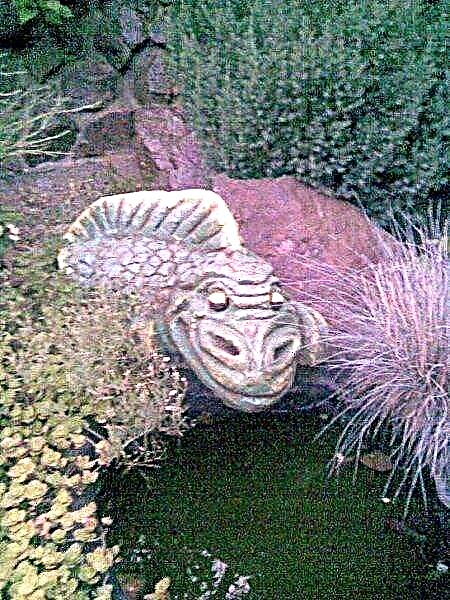
It is made of concrete monolith with a knife.
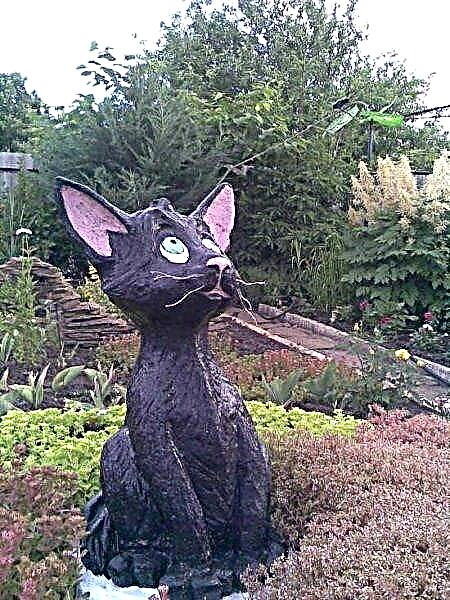
The cat is tall - more than 160 cm at the base of the pin. The head was made separately, then connected to the "body"
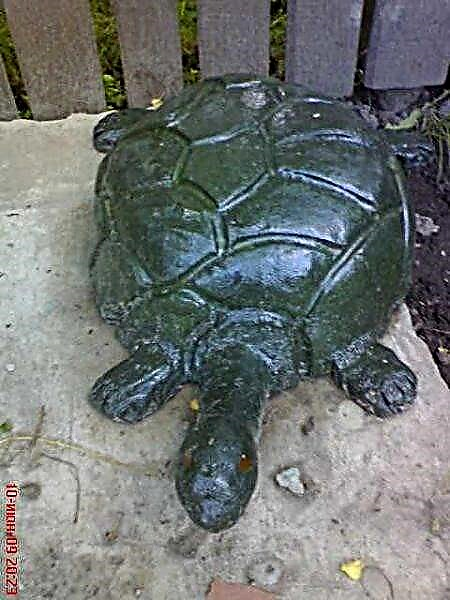
Tortoises and mushrooms made of concrete - their beginner sculptors do most often
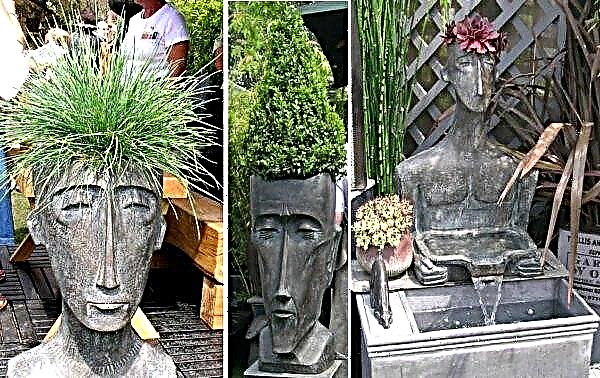
Such sculptures need a form ...
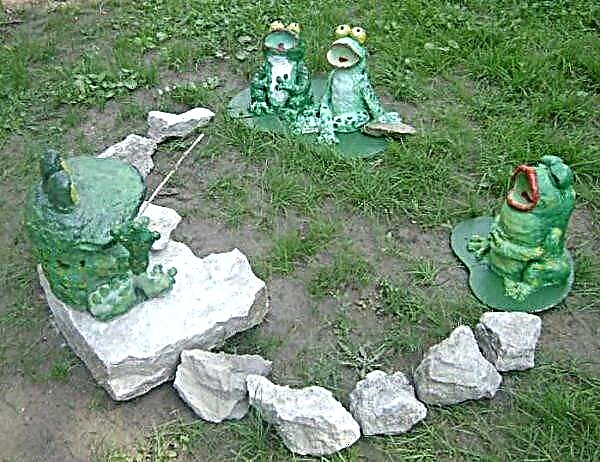
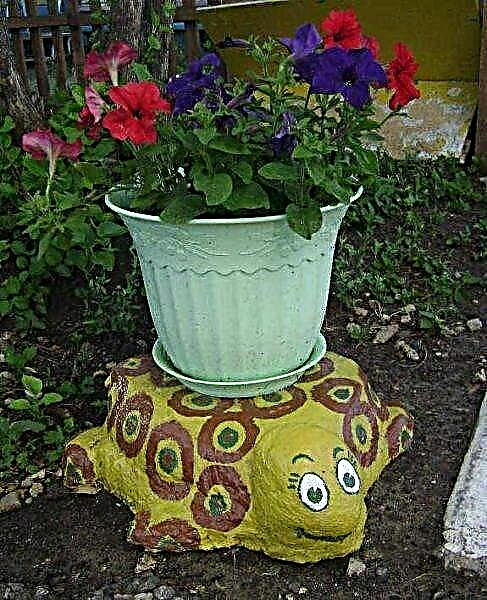
From the remnants of concrete ...

These are plaster figurines for the garden, but they should not be left for the winter.
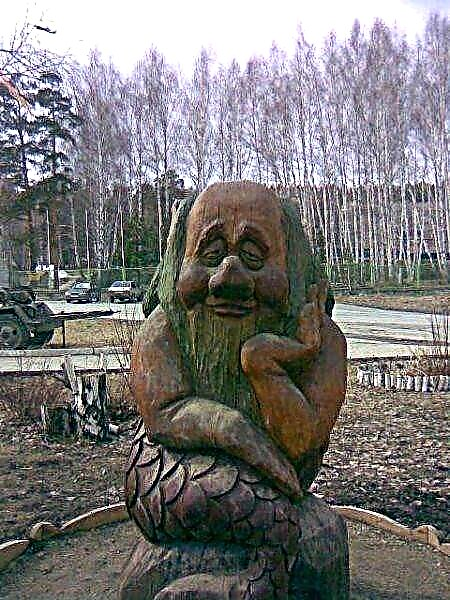
The wooden sculpture for the garden and the garden is a talent ...
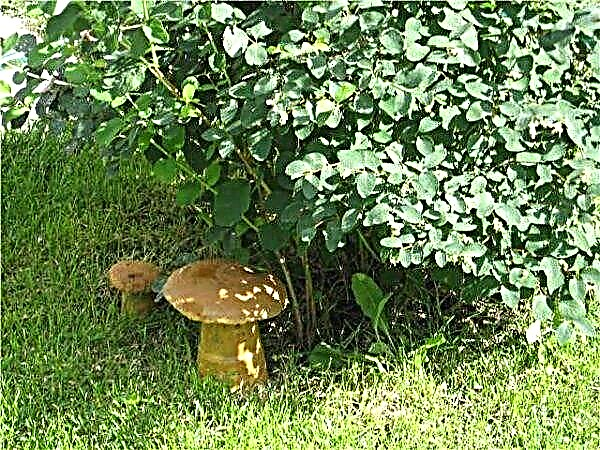
Mushrooms made of concrete - a plastic cup for a leg and a bowl for a hat. In the future hat, until the solution has hardened, dig a cylindrical hole - so that the leg goes into it. So the fungus will be very similar to real

